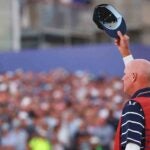Why Jon Rahm left for LIV Golf

Jon Rahm spoke with David Feherty in the hours following his announcement.
LIV Golf
Ah, 2023. The year everything changed … again. For the second straight year, we left 2023 with a drastically different perspective of professional golf than we entered. Now, as we look back at the year that was — with LIV major championships, Ryder Cup controversies and oh so many other stories — we’re remembering the 15 biggest moments that defined the year in golf. Let’s get digging.
Biggest Golf Moments of 2023 …
No. 15: Viktor Hovland’s arrival
No. 14: Fowler, Day back in the winner’s circle
No. 13: Brian Harman’s Open rout
No. 12: The Michael Block Party
No. 11: Wyndham Clark’s breakout
No. 10: Lilia Vu’s rise
No. 9: LIV Golf’s OWGR snub
No. 8: The players regain control
No. 7: Ciganda’s Spanish Solheim triumph
No. 6: Tiger Woods’ 2023 return
No. 5: Brooks Koepka’s PGA Championship triumph
No. 4: Ryder Cup gets testy
Jon Rahm’s 2023 began with a bang. On Sunday at the Sentry, the boosted-purse event that was supposed to usher in a new era for the PGA Tour, Rahm came from seven shots back with 11 holes to play to win his first of four events on the season — including one you’ve likely heard of called the Masters.
Jon Rahm’s 2023 finished with a bang, too. You know the scene: Black letterman jacket. LIV Golf logo. Bret Baier questions. The beginning of a new era.
A big question felt half-answered: Why? Why’d Rahm pull a 180 on his previous rejections of LIV’s format? What happened that made the difference? What combination of money and leverage and timing and distaste for the doings on the PGA Tour? In the days that followed I tried to put it together; below is the where I ended up.
My story on Rahm and his high-profile departure, which lands at No. 3 on our list:
***
In the days since Jon Rahm’s momentous LIV announcement, the golf world has tried to make sense of his decision.
This conjecture actually began in the days and weeks before his departure. Persistent rumors coupled with Rahm’s silence to produce an information vacuum, and there’s no better place for speculation to thrive. Surely Rahm must be plotting a chess move, or this was some sort of Trojan Horse, or perhaps a complex play at reunification?
It was somewhat jarring, then, to face the reality of Rahm’s explanation. Given his past opposition to LIV and his dismissal of its format and “meh” reaction to the idea of $400 million, we expected something momentous to accompany Rahm’s about-face. But in his introductory press appearances, he trotted out a remarkably familiar set of LIV-related talking points.
The move, he said, was “best for me and my family.” He said the team aspect was “absolutely key.” He said he likes the LIV product and the business. He said his decision had nothing to do with Phil Mickelson nor Sergio Garcia. He said he’d received no assurances about the Ryder Cup nor guarantees about a deal. He used the phrase “growing the game” once, twice, thrice. And he quickly aligned himself with Saudi Arabia’s ongoing sports investment.
“I can’t really speak on what their plan is for all this and their future, but clearly they’re trying to create a positive impact in sports,” he said. “And, you know, I’m happy that in a small way, I can maybe help with that.”
The controlled comments presented a striking contrast to Rahm’s usual appearances. One hallmark of Rahm’s press conferences has become a pause followed by the phrase, “I wouldn’t know what else to say about that,” which would generally precede a thoughtful, honest, lengthy answer that would reveal he did in fact have more to say about the subject at hand. This time it was the opposite: he knew what he wanted to say and he knew he didn’t want to say too much. Understandably, Rahm was careful and guarded, given the sensitivity of the situation. It was just a reminder of how things have changed.
Rahm’s departure: When and why?
We got more details on the when and the why during Rahm’s appearance on ESPN’s Pat McAfee Show on Friday morning. He was more at ease in a friendly environment (McAfee called the decision “honorable, incredible and inspiring”) and laid out the timeline from his perspective.
“I had my agent under strict instructions: Until you think this is a really good idea for me, don’t bring it up,” Rahm explained. “So I do believe they were talking to [LIV] since the beginning of LIV Golf, they just never brought it up to me.”
That makes sense, given Rahm shares an agency with LIV founding member Phil Mickelson. As to what made it a “really good idea?”
“This year we thought it was good timing, with winning a major, being exempt to the majors, having made quite a bigger name for myself with the golf I’ve played through the last few years, we thought it was good timing and that’s when they brought it up to me. The landscape of golf is ever-changing right now, especially the last few years. And after seeing LIV Golf in action and seeing what they have to offer, and being part of a team is so nice — then it became a possibility.”
While Rahm was careful not to blame the PGA Tour’s ongoing turbulence for his departure, that reference to the “ever-changing” golf landscape was probably a hint. Things may look different now had the framework agreement of June 6th been constructed and communicated differently. The PGA Tour seeking partnership with the PIF lowered the threshold for players to do the same.
That was the lens through which Rory McIlroy viewed the move.
“The landscape of golf changed on June 6th,” he told Sky Sports. “This framework agreement legitimized, basically, what LIV was trying to do.”
Money was, of course, the determining factor.
“Obviously the money is very very nice, I’m not gonna give you the whole spiel,” Rahm said. “I don’t play golf for money but as a father, as a husband, as a family man I do owe it to my family to set them up the best I can and luckily I have that possibility, so yeah. That was a big part of it.”
In other words, for as different as Rahm’s departure seems in terms of timing and circumstance, the decision itself was a case of simple business fundamentals. Timing, leverage and money. The timing was perfect; his Masters victory means he’ll play Augusta for the rest of his career and have exemptions into five years of majors, while leaving shortly after the Ryder Cup means the golf world has two years to sort out how to get him on the next European team. (“If there was someone who was a good candidate, it’d probably be him,” Jason Day told SI.) His leverage was elevated by that Masters victory; LIV loves collecting green jackets and Rahm’s camp would have known the defending champion can demand a premium. After that, it was just a matter of hammering out the details and LIV ponying up the dollars to make it worth his while.
“They really went put me in a position where I had to think about it, and I did,” Rahm said.
There’s more at play here, of course. There’s a team of pros Rahm is helping to assemble; additional signees are expected to follow in his wake. Rahm also negotiated directly with LIV’s higher-ups, so he should be well aware of what’s at play. But to take Rahm at his word, he wasn’t masterminding anything larger for the golf world. The reasons for him to leave just finally outnumbered the reasons not to.
Editor’s Picks
“It seems like this decision was made completely independent of whatever negotiations might be happening,” one reporter asked on Thursday. “Is that correct?”
“That is correct,” Rahm said. “I’ve tried to figure out the words I can think about in Spanish — I’ve made myself not absent, but separated myself from those negotiations.”
But even if Rahm isn’t the one doing it, there is bigger-picture masterminding going on. Rahm’s move has significant implications for the ongoing deal between the PGA Tour and the Saudi PIF; the Saudis now have increased leverage and Rahm is a well-paid pawn in their ongoing chess match or, as Justin Rose called it, a jigsaw puzzle. His signing is both a negotiating tactic and a threat of what could follow.
“It’s a really nice play by them,” Jordan Spieth conceded to the AP on Saturday. “I think we hold the best hand, but they know what our hand is. It’s a nice leveraging tool with everything going on.”
Rahm seems content with that role. Even though his departure weakened the PGA Tour’s position, there was nothing divisive whatsoever about his remarks; he clearly has no interest in being part of a turf war. He went out of his way to say he wasn’t frustrated with the PGA Tour’s direction. He thanked Tiger Woods, Rory McIlroy and Patrick Cantlay for their work in governance. He said if it’s up to him he’ll keep status on the PGA Tour and DP World Tour. Whether that’s an actual possibility remains to be seen.
Rahm has always been an obsessive student of golf history and values his place within it. In part Thursday’s announcement seemed to signal a departure from his childhood dreams — dreams we’d assumed weren’t for sale. But in reality, Rahm can still likely chase all the major championships and Ryder Cups that his golf game allows. Plus there’s the possibility that this will help trigger a reunification after all; Rahm may yet be able to have his cake and eat it, too.
Time will tell who joins him.
Dylan (cautiously) welcomes your comments at dylan_dethier@golf.com.








